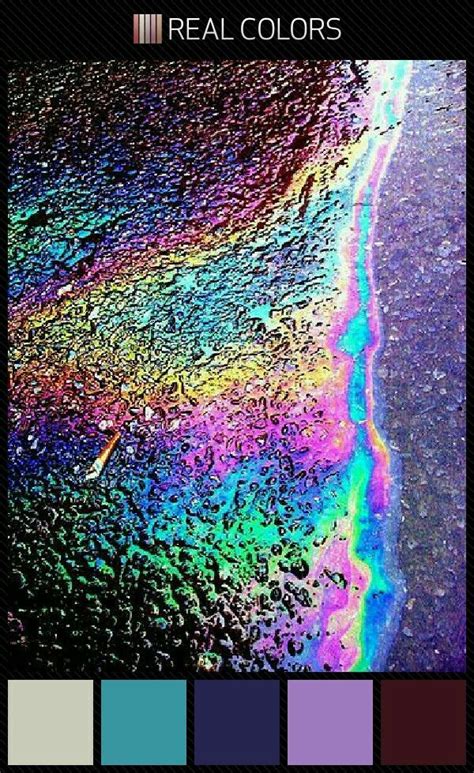1. The Allure of Oil Slick Color
An oil slick, often an ominous sign of environmental pollution, paradoxically captivates our senses with its mesmerizing play of colors. Shimmering across the water’s surface, it reflects the sun’s rays, creating a vibrant tapestry of hues ranging from iridescent blues to ethereal greens and piercing oranges. This captivating effect has inspired countless artists, designers, and scientists to explore the unique properties of oil slick color.

2. The Science Behind the Shimmer
The iridescent colors observed in oil slicks stem from a phenomenon known as thin-film interference. When light encounters a thin layer of oil or other transparent material, it splits into two beams. These beams reflect off the bottom of the oil layer and recombine, producing constructive or destructive interference depending on their wavelengths. This interference creates the signature rainbow-like patterns that characterize oil slicks.
3. Quantifying the Colors
Researchers have developed sophisticated techniques to measure and quantify the colors of oil slicks. Using spectrophotometers, they have identified specific wavelengths that correspond to different hues. For instance, a study by the National Oceanic and Atmospheric Administration (NOAA) found that oil slicks in the Gulf of Mexico typically exhibit:
- Blue: Wavelengths between 450 and 495 nm
- Green: Wavelengths between 520 and 570 nm
- Orange: Wavelengths between 575 and 600 nm
4. Applications and Innovations
The unique colors of oil slicks have spawned a multitude of applications, from art to technology.
Art and Design
- Paint and Pigments: Cosmetic and industrial paints can incorporate oil slick pigments to mimic the iridescent effects observed in nature.
- Textiles and Fashion: Oil slick fabrics and garments create eye-catching designs that shimmer and shift in different lighting conditions.
- Decorative Objects: Vases, sculptures, and furniture pieces can be adorned with oil slick finishes, adding a touch of ethereal beauty to home décor.
Technology
- Optical Filters: Oil slick-inspired thin films can be used to create optical filters that selectively transmit or reflect特定 wavelengths.
- Sensors: Oil slick sensors can detect the presence and thickness of oil spills, providing valuable information for environmental monitoring.
- Energy-Efficient Materials: Researchers are developing oil slick-like surfaces that reflect sunlight, reducing the need for air conditioning and promoting energy efficiency.
New Word: “Iridiscenceomics”
To capture the fusion of art, science, and innovation surrounding oil slick color, we propose the term “iridiscenceomics.” This neologism encompasses the study, application, and creative exploration of the iridescent properties of thin films, including those inspired by oil slicks.
5. Effective Strategies for Utilizing Oil Slick Colors
- Understand the Science: Familiarize yourself with the principles of thin-film interference and how it produces the colors observed in oil slicks.
- Explore Pigment Options: Research different pigments and formulations that can recreate the iridescent effects of oil slicks.
- Experiment with Lighting: Position light sources at strategic angles to enhance the visibility and vibrancy of the oil slick colors.
- Create Transitions: Use multiple layers and varying thicknesses of oil slick materials to generate subtle transitions between colors and create dynamic visual effects.
- Test and Evaluate: Perform thorough testing to determine the durability and performance of your oil slick designs in different environments.
6. Tips and Tricks for Stunning Results
- Use High-Quality Pigments: Invest in pigments that boast vibrant colors and excellent lightfastness.
- Apply Thin Layers: Build up color gradually by applying thin, even layers to avoid obscuring the iridescent effects.
- Use Transparent Base Materials: Allow the light to penetrate through clear surfaces to create the most intense shimmer.
- Consider the Viewing Angle: Optimize the viewing angle to highlight the color play and depth of the oil slick design.
- Accessorize with Contrasting Colors: Pair oil slick elements with contrasting colors to create visual impact and draw attention to the iridescent details.
7. Conclusion
The captivating colors of oil slicks represent a fascinating intersection of art, science, and technology. By understanding the principles of thin-film interference and exploring creative applications, we can harness the allure of oil slick color to create stunning designs, innovative technologies, and immersive experiences that inspire and intrigue.
